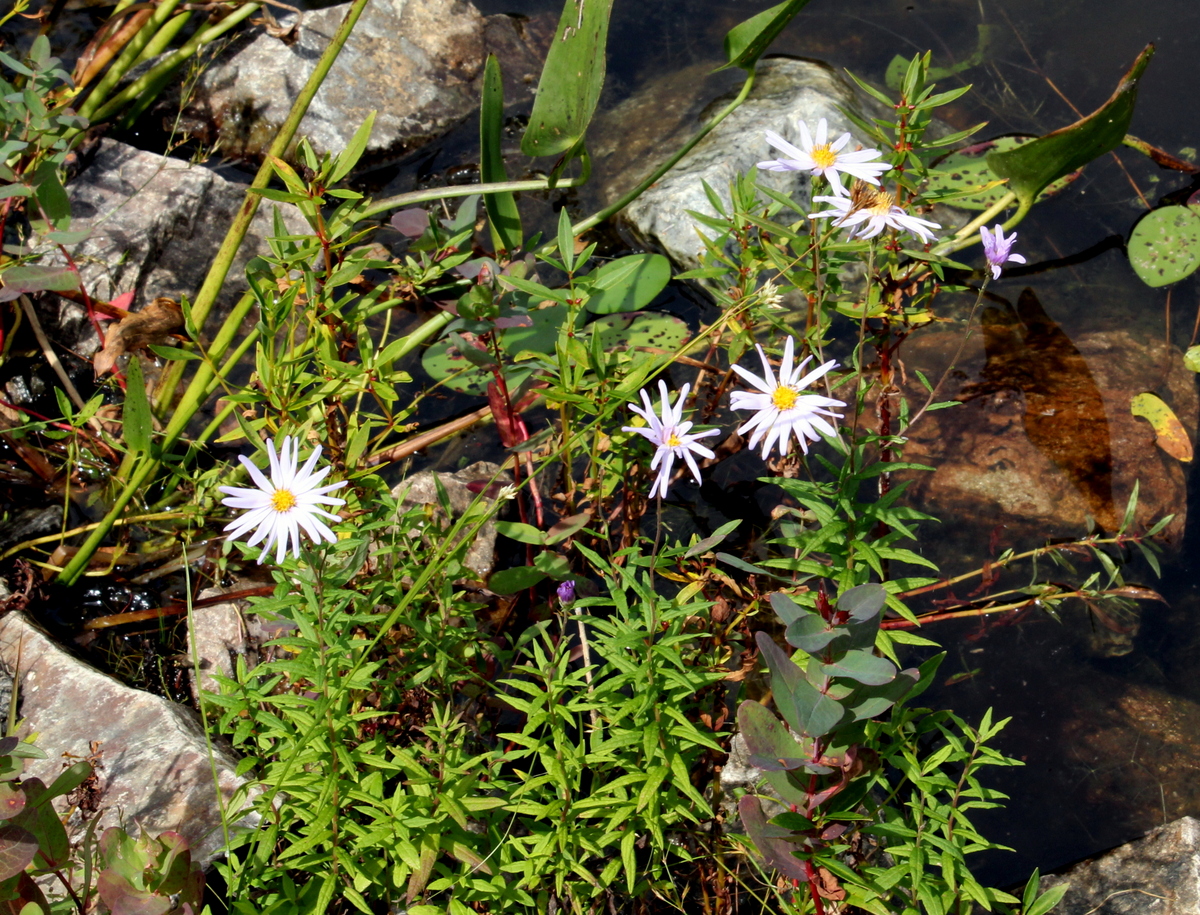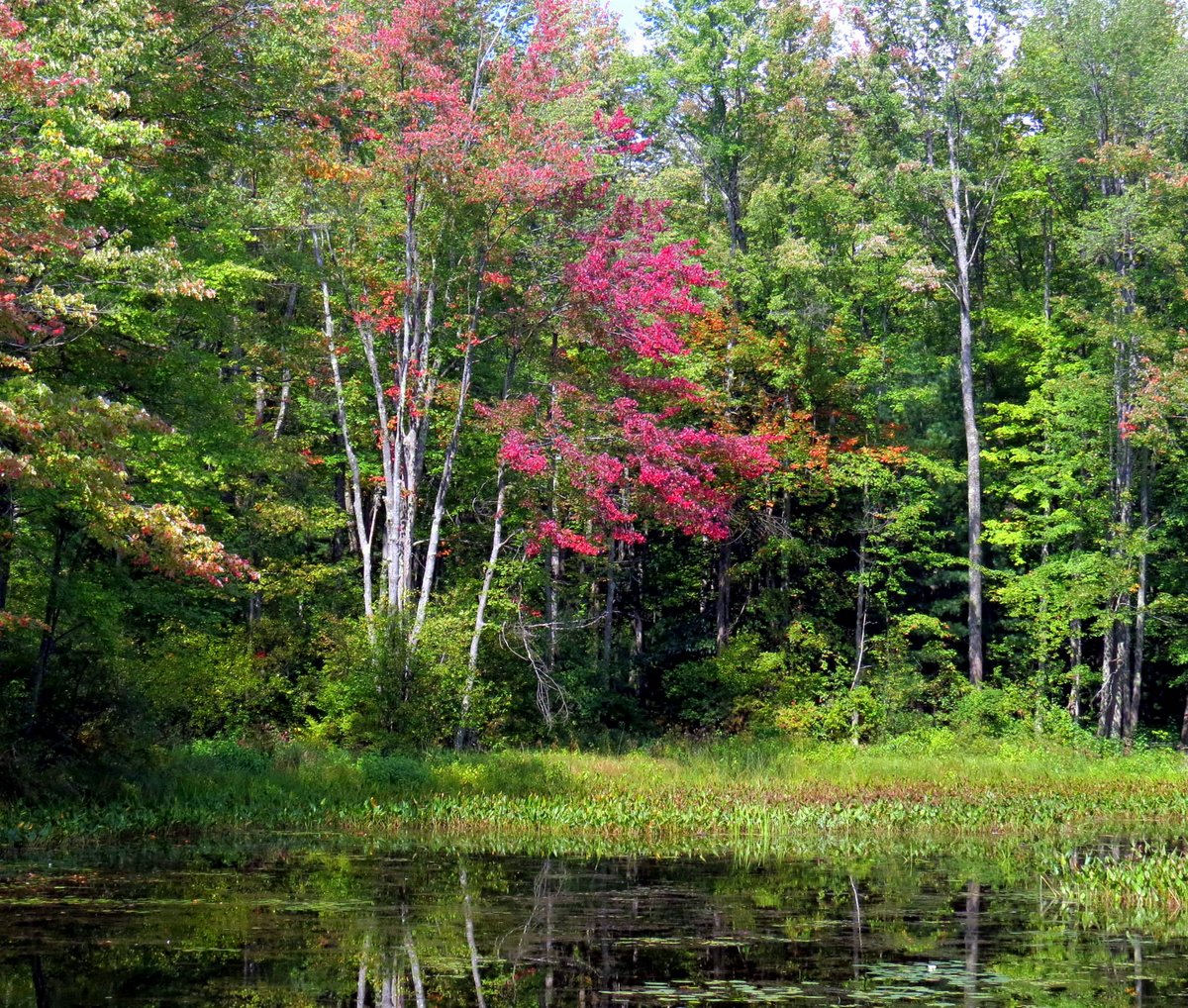
There is only one place to find bog asters and sneezeweed in this area that I know of, and that is at Meetinghouse Pond in Marlborough, so off I went recently to see what I could find. I was hoping the mower hadn’t beaten me to it.

Luckily, they hadn’t mowed the earthen dam. It’s a relatively small area but what a wealth of flowers grow here. I really had no idea until I started taking photos how many different plants there were. I ended up finding more than enough to fill an entire blog post, all from this small piece of land.

And there were the rare and beautiful little bog asters (Oclemena nemoralis) growing in the shallow water at the pond edge. The fact that they can grow in standing water and have a single white or purple flower at the top of a foot tall stem makes these asters hard to confuse with any other.

Because bog asters usually grow in thickets in wet, swampy areas many people never see them. They grow along the shore of this pond in great numbers but this is the only pond I’ve seen that happen in, so there must be something special about this place. I’ve read that they can stand temperatures as low as minus 40 degrees F. Each flower is about half the size of a New England aster. The small, sword shaped leaves have no stems (petioles) and that’s another way to identify them. They grow in the northeastern U.S., west to Michigan’s upper peninsula, and in and parts of Canada in or near cold, acidic ponds and peaty bogs. The Native American Chippewa tribe used the roots of this plant to treat earaches.

Another plant I find growing at pond and river edges is beggar’s ticks (Bidens). They are the small orange flowers seen here and there in this shot. They appear in late July and grow for several weeks before showing flowers. There are nearly 200 species in the genus and many of them look nearly identical. In this part of the state this plant grows side by side with the nodding burr marigold (Bidens Cernua,) which is also called smooth beggar’s ticks and looks very similar. The plant gets its common name from the way its barbed seeds cling to clothing. Books say that it reaches 3 1/2 feet tall but I’ve seen some get close to six feet. The one in the photo is more typical of its often-sprawling habit.

It’s often hard to tell if a beggar’s tick blossom is fully opened but I think this one was more open than any I’ve seen. When I see them I always think of fall.

Tansy (Tanacetum vulgare) is another plant that always reminds me of fall. This is one of only three places i’ve ever found this European native in the wild. I always think of it as a daisy with no petals.

Black eyed Susans (Rudbeckia hirta) are flowers that I’ve always thought of as fall flowers so when they appear in June I can’t say that I’m overjoyed to see them but on this day, they fit right in. That of course, is just an opinion in my mind. They add as much cheer to the landscape in June as they do in September and I should be just as happy to see them then as I am now.

There were two ox-eye daisies (Leucanthemum vulgare) still blooming and this was the best of the two. Most of the petals had been eaten off the other one, by what I don’t know. This is a late time for them to be blooming but I was happy to see them. They always remind me of my wedding day. We didn’t have much money so we picked hundreds of daisies and put some in a vase on each table. They wilted in about 5 minutes and I can still see their sad faces in my mind to this day. Better to leave them in the fields where they belong. They and we will be happier that way.

Bird’s foot trefoil (Lotus corniculatus) does well here. It’s in the pea family and grows about a foot tall, and is a common sight along roadsides and waste areas. The plant has 3 leaflets much like clover and was introduced from Europe as livestock feed, but has escaped and is now considered invasive in many areas. It can form large mats that choke out natives but that wasn’t happening here.

Red clover (Trifolium pretense) grew here in abundance and was as beautiful as ever.

White daisy fleabane flowers (Erigeron strigosus) can appear pink in the right light, but they were white on this day. I regularly find fleabane growing in sunny spots quite deep in the woods where you wouldn’t expect it to be, but it was getting plenty of sunshine here.

Crown vetch (Securigera varia) is often used on roadsides to stabilize embankments and control erosion so I wasn’t surprised to find it here on this earthen dam. I think it’s a beautiful flower, even if it is invasive. Some of the other flowers here, like bird’s foor trefoil, are used in the same way.

For the first time I saw the tiny seed pods of rabbit’s-foot Clover (Trifolium arvense.) If you look closely, you can see them at the base of the flower head, poking out of the feathery, grayish- pink sepals. These feathery sepals are much larger than the petals and make up most of the flower head. This plant is in the pea family and is used to improve soil quality. It is originally from Europe and Asia and is considered an invasive weed. It gets its name from the fuzzy flower heads, which are said to look like a rabbit’s foot.

Goldenrod grew here of course, in at least three different forms. There was downy goldenrod, slender fragrant goldenrod and this one, which I think is tall goldenrod (Solidago altissima) since it was taller than I am.

I’m not sure which aster this was but its blue green foliage, lack of hairs on the leaves and stems, smallish 1-inch flowers, and lack of leaf petioles all point to the smooth blue aster (Aster laevis.) Also, the plants grow as a single stalk for part of their height before branching, and that’s another identifying characteristic. Asters can be very tricky to identify though, so I can’t say that I’m positive about it.

And speaking of asters that are tricky to identify, I’ve been trying for years to name this one. At first I thought it was the heath aster but I never really felt super confident about that. I needed an aster with small white flowers that grew on only one side of the stem, and that perfectly fits the description of the small white aster (Symphyotrichum racemosum,) also called the old field aster. Once again, I have to thank the Saratoga Woods and Waterways blog for leading me to its name. I do hope everyone who loves nature is reading that blog. It’s one of my favorites and you can find a link to it over there on the right in the favorite links section.

Finding yarrow (Achillea millefolium) here wasn’t a surprise but seeing it look so good this late in the year was. Yarrow often has a second bloom but the flower heads are much smaller than the first bloom, so I think these were still in their first bloom. They might have been mowed as well though, and bloomed later than usual. In any event they looked just as good as they do in June. We humans have used common yarrow in various ways for thousands of years, since before recorded time. Once thought of as sacred, it has even been found in Neanderthal graves.

I always expect to find smartweeds near water and there were a few different species here. The ducks and other waterfowl won’t have any trouble getting onto the dam to pick their seeds.

This pond is the only place I know of to find native sneezeweed (Helenium autumnale.) I’ve never seen it anywhere else in the wild and I don’t know how it got here, but it is always worth the drive to see it. Last year I got here too late and it had been mowed. I wish they’d wait until after a frost to mow so people could enjoy the flowers.

Sneezeweed’s common name comes from its dried leaves being used as snuff. It was inhaled to cause sneezing because sneezing was thought to rid the body of evil spirits, and both men and women used it. The plants have curious winged stems and this is a good way to identify them. It is a poisonous plant and no part of it should be eaten. It also contains compounds that have been shown effective in the treatment of tumors. The Native American Cherokee tribe used the plant medicinally to induce sneezing and as an aid in childbirth.

I was so surprised to find all of these flowers in such a small space. Even the grasses were in full bloom. I think this was Timothy grass but it was so full of flowers I couldn’t tell. I hope they’ll hold off on the mowing so other people can see the rarer flowers like bog asters and sneezeweed. Or at least mow around them. We have an earthen dam where I work so I know what the law says about the importance of keeping them free of brush and trees, but mowing once each year takes care of that. Maybe next time the mower comes he’ll see all the beauty before he mows, and will just sit and enjoy this place instead of cutting. Maybe the lion really could lie down with the lamb, just for a time.
When was the last time you spent a quiet moment just doing nothing – just sitting and looking at the sea, or watching the wind blowing the tree limbs, or waves rippling on a pond, a flickering candle or children playing in the park? ~Ralph Marston
Thanks for coming by.
































































































































































































